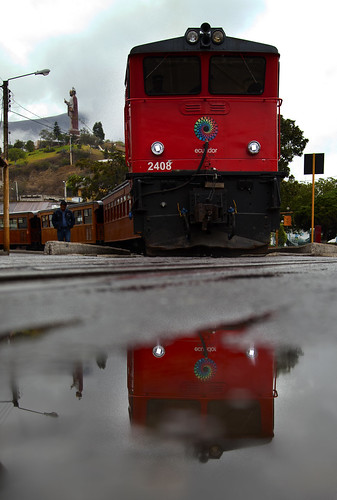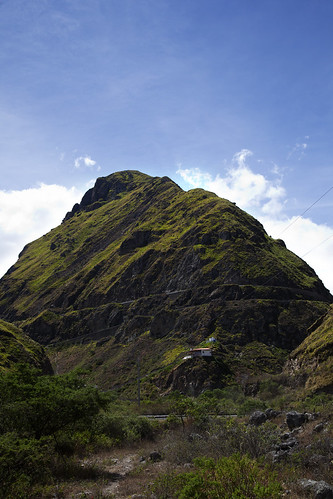There are a few other differences I noticed between El Tren and the East Coast Mainline. Instead of rolling past hundreds of miles of flat, fertile farmland interspersed only by depressing commuter belt towns (Stevenage, I'm looking at you) I was snaking down a precarious mountainside watching the flora change before my eyes from high Andean to exotic broad-leafed sub Tropical Triffids. On the downside, my carriage was filled with silver-haired American tourists who were as obnoxious as they were fat.
 |
| Riding down the Devil's Nose from Alausi |
Considering the sacrifice made by these men, it's rather a shame there's no monument to them or more than a passing mention of their deaths. We were all happily rolling down a breathtaking track enjoying the fruits of their fatal labour at a rate of 20 dead Jamaicans per minute. It's little wonder this section of the line is reportedly haunted.
 |
| Leaving Alausi station |
 |
| If you use your imagination, this is the Devil's nose |
The Devil's Nose section has to bridge a 1000 metre difference in altitude in just over 10 kilometres. The ratio is too steep to lay a standard track, it would make Alton Towers' latest roller coaster look tame. The solution is to build a series of switchbacks to soften the gradient, a back and forth ride, much like the swing of a pendulum.
It's amazing the changes in the landscape as you descend. The thermometer also rises steadily. We passed scrappy fields of maize outside Alausi, corn grows well in even the poorest soil of the high Andes, to more exotic sub-tropical plants and fruit.
The Devil's nose is just a small section in a much vaster 600 mile network that runs from Quito (in the highlands) to Guayquil (Ecuador's major port). Before the train was running it used to take over three weeks for a mule caravan to make the back-breaking trudge from the coast to the capital, and that was only when the weather was good. By train the journey took just two days. Understandably, the oxygen-starved citizens of Quito celebrated its arrival with a frenzy of new-found commercialism.
The train first ran in the 1890s and continued in slow decline for over 100 years. Lucy can remember taking the train as a child when it was still packed with animals heading to market and you had to sit on the roof, like in India. Apparently a couple of Japanese tourists fell off and have spoiled it for the rest of us.
A particularly bad El Nino in the late 90s finished off large sections of the ageing track and it was abandoned without so much as a fare you well. Fortunately, Ecuador's most important President of the last 50 years recognised its potential as a tourist attraction. Rafael Correa ordered the most spectacular sections of the line to be renovated (like the Devil's Nose, or the Route of Ice which reaches altitudes of over 3,600 metres). The plan worked and El Tren is packed, albeit more tightly than ever before, with our remarkably rotund cousins from North America.
They've done a great job restoring not only the track but also the trains and the infrastructure. Each carriage gets a guide, who points out the most interesting landmarks and narrates the history of the track. When you arrive at the station there is an Indian folk dance group waiting to greet you and a couple of patient llamas for a photo op. You even get a free drink and snack from the cafe. It costs about $25 for a ticket but it's a good few hours entertainment and there isn't very much like it anywhere else in the world.
In terms of engineering undertakings I'd still give the top prize to the Trans Siberian Railway, which crosses 6,600 miles of bitter Russian steppe. But even the vastness of the TSR can't match what El Tren has to offer in terms of diversity. It puffs up from the Pacific coast where blue whales visit to breed, through cloud forest, and rain forest, to the rich sub-Tropical wetlands, and then with a monumental grind, up into the high Andes and passing snow-capped volcanoes, all the way to the lofty capital of Quito.
 |
| A section of the switchback track |

Live CockFighting Baccarat Betting in Indonesia. The cocks are grown specifically to fight to make them aggressive by crows. Enjoy your great time at.
ReplyDeletesabung ayam
judi sabung ayam
agen sabung ayam online
sabung ayam s128
bolavita s128
s128
WA : +62812-2222-995